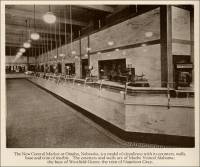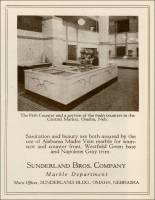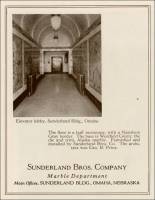


Structures and Monuments in Which Missouri Stone was Used
- Finished Products from Missouri Stone in
Nebraska
-
Blair, Nebraska – the Blair Court House Building (from Missouri Marble,
by Norman S. Hinchey, Report of Investigations No. 3, Missouri Geological
Survey and Water Resources, Rolla, Missouri, 1946. Used with permission
of the Missouri Department of Natural Resources.)
Warrensburg sandstone quarried from the Pickel Sandstone Quarry located north of Warrensburg, Missouri, was used in the construction of the Blair Court House building prior to 1904.
- Boyd, Nebraska - the Boyd’s Opera House, Farnam Street & Fifteenth Street (The following information is from History of the State of Nebraska, first published in 1882 by The Western Historical Company, A. T. Andreas, Proprietor, Chicago, IL., Chapter on Douglas County, presented on the NEGenWeb Project Kansas Collection Books web site.
“The ground covered by the Opera House is seventy-seven feet front on Farnam Street, and 132 on Fifteenth street. The foundation of the structure was begun in November, 1880, the footings being put in at that time. Its opening entertainment was October 24, 1881...The main portion of the building is four stories high, while the rear part, containing the stage, is five stories. The height of the building from the ground is eighty-six feet. The building is constructed of St. Louis pressed brick, and Missouri sandstone, the latter being carved in various designs, and forming the ornamental trimmings. The main cornice is seventy-one feet above the sidewalk, and is made of galvanized iron, with a large pediment in the center on Farnam street, with illuminated glass letters, ‘Boyd’s Opera House,’ in the panel of the pediment. Just below this, carved in Missouri sandstone, is the following inscription: ‘18-J. E. Boyd-81.’ The general style of architecture is American renaissance.”
- David City, Nebraska - the David City Court House Building (from Missouri Marble,
by Norman S. Hinchey, Report of Investigations No. 3, Missouri Geological
Survey and Water Resources, Rolla, Missouri, 1946. Used with permission
of the Missouri Department of Natural Resources.)
Warrensburg sandstone quarried from the Pickel Sandstone Quarry located north of Warrensburg, Missouri, was used in the construction of the David City Court House building prior to 1904.
- Fairbury, Jefferson County, Nebraska - the Thomas Harbine Bank
(AKA Banking House of Thomas Harbine) The following information
is from Andreas’ History
of The State of Nebraska,
“Thomas Harbine’s Bank. - This is the only bank at present in the place, but the building for another is now under contract....”
“The bank building is the finest and most ornamental building in the place. It is built of white sandstone from Carroll County, Missouri, and with the fixtures cost nearly $7,000.”
- Lincoln, Nebraska - the Grant Memorial Laboratory of Nebraska (from Missouri Marble,
by Norman S. Hinchey, Report of Investigations No. 3, Missouri Geological
Survey and Water Resources, Rolla, Missouri, 1946. Used with permission
of the Missouri Department of Natural Resources.)
Warrensburg sandstone quarried from the Pickel Sandstone Quarry located north of Warrensburg, Missouri, was used in the construction of the Grant Memorial Laboratory of Nebraska building prior to 1904.
- Lincoln, Nebraska - the Lincoln Court House Building (from Missouri Marble,
by Norman S. Hinchey, Report of Investigations No. 3, Missouri Geological
Survey and Water Resources, Rolla, Missouri, 1946. Used with permission
of the Missouri Department of Natural Resources.)
Warrensburg sandstone quarried from the Pickel Sandstone Quarry located north of Warrensburg, Missouri, was used in the construction of the Lincoln Court House building prior to 1904.
- Lincoln, Nebraska - the Lincoln Normal University Building(s) (from Missouri Marble, by Norman S. Hinchey, Report of Investigations No. 3, Missouri Geological Survey and Water Resources, Rolla, Missouri, 1946)
Warrensburg sandstone quarried from the Pickel Sandstone Quarry located north of Warrensburg, Missouri, was used in the construction of the Lincoln Normal University building(s) prior to 1904.
- Lincoln, Nebraska - the Lindell Hotel (from Missouri Marble, by Norman S. Hinchey, Report of Investigations No. 3, Missouri Geological Survey and Water Resources, Rolla, Missouri, 1946)
Warrensburg sandstone quarried from the Pickel Sandstone Quarry located north of Warrensburg, Missouri, was used in the construction of the Lindell Hotel building prior to 1904.
- Lincoln, Lancaster County, Nebraska - the
Lunatic Asylum (history
and photograph) According to this web site, the information was obtained
from Andreas’ History
of The State of Nebraska.
During the building of the Lunatic Asylum, fires were set and the building was destroyed after the second fire. It was rebuilt using sandstone from Carrol County, Missouri and was completed in October 1872.
- Lincoln, Nebraska - the Lyman Terrace (from Missouri Marble, by Norman S. Hinchey, Report of Investigations No. 3, Missouri Geological Survey and Water Resources, Rolla, Missouri, 1946)
Warrensburg sandstone quarried from the Pickel Sandstone Quarry located north of Warrensburg, Missouri, was used in the construction of the Lyman Terrace prior to 1904.
- Lyman Terrace - According to the Nebraska State Historical Society National Register Sites, Lyman Terrace is one of three remaining nineteenth-century terrace or row houses in Lincoln.
- Lincoln, Nebraska - the Sandstone used in the Lincoln Area (from The Quarrying Industry of Missouri, by E. R. Buckley, Director and State Geologist, and H. A. Buehler, Missouri Bureau of Geology and Mines Vol. II, 2nd Series, 1904.)
“The Carroll County Sandstone Company, by which (the White Rock sandstone) quarry is owned, is a corporation consisting of A. T. Kendrick, B. D. Kendrick, O. A. Kendrick and Wm. Bushy. The quarry was opened in 1868 and has been operated almost continuously ever since....”
“As a whole, the stone consists of fine rounded grains of translucent quartz, cemented together chiefly with calcium carbonate. Small flakes of mica, grains of iron oxide and nodules of pyrites are lesser constituents of the rock. Large oval areas in the stone have been changed practically to a quartzite....”
“This sandstone has been used in the construction of the Iowa State Capitol, the Methodist Church at Carrollton, the Public Library at Fulton and for bridge abutments along the Wabash railroad. It has also been shipped to the following cities for miscellaneous uses: St. Joseph, St. Louis, Kansas City and Marysville, Missouri; Lincoln, Nebraska; Ottumwa, Des Moines, Atlantic, and Bloomfield, Iowa.”
- Lincoln, Nebraska - the Union College Building(s) (from Missouri Marble, by Norman S. Hinchey, Report of Investigations No. 3, Missouri Geological Survey and Water Resources, Rolla, Missouri, 1946)
Warrensburg sandstone quarried from the Pickel Sandstone Quarry located north of Warrensburg, Missouri, was used in the construction of the Union College building(s) prior to 1904.
- Marysville, Nebraska - the Sandstone used in the Marysville Area (from The Quarrying Industry of Missouri, by E. R. Buckley, Director and State Geologist, and H. A. Buehler, Missouri Bureau of Geology and Mines Vol. II, 2nd Series, 1904.)
“The Carroll County Sandstone Company, by which (the White Rock sandstone) quarry is owned, is a corporation consisting of A. T. Kendrick, B. D. Kendrick, O. A. Kendrick and Wm. Bushy. The quarry was opened in 1868 and has been operated almost continuously ever since....”
“As a whole, the stone consists of fine rounded grains of translucent quartz, cemented together chiefly with calcium carbonate. Small flakes of mica, grains of iron oxide and nodules of pyrites are lesser constituents of the rock. Large oval areas in the stone have been changed practically to a quartzite....”
“This sandstone has been used in the construction of the Iowa State Capitol, the Methodist Church at Carrollton, the Public Library at Fulton and for bridge abutments along the Wabash railroad. It has also been shipped to the following cities for miscellaneous uses: St. Joseph, St. Louis, Kansas City and Marysville, Missouri; Lincoln, Nebraska; Ottumwa, Des Moines, Atlantic, and Bloomfield, Iowa.”
- Omaha, Nebraska - the Central Market - Trim (from Throvgh The Ages Magazine, “Store Fronts and Interiors of Marble: The modern tendency is towards the more lavish use of this most beautiful of materials,” by
John Freund, Architect, Baltimore, Maryland, December 1923, Vol. 1, No.
8, pp. 22.)
View of the interior of the New Central Market, in Omaha. The counters and walls are Marde Veined Alabama, the bases Westfield Green, and the trim Napoleon Gray. 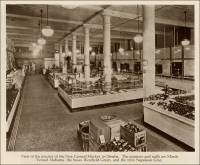
- Omaha, Nebraska - the Central Market (from Stone Magazine, April 1924, Vol. XLV, No. 4, pp. 229)
- Omaha, Nebraska - the Central Market (from” Marble As An Interior Finish,” by John Stephen Sewell, Birmingham, Alabama, in Throvgh The Ages Magazine, February 1925, Vol. 2, No. 10, pp. 23-31.)
- Omaha, Nebraska - the Central Market - the Fish Counter & a Portion of the Main Counters (from Throvgh The Ages Magazine, April 1927, Vol. 4, No. 12, pp. 50.)
Sunderland Bros. Company, Marble Department - Main Offices, Sunderland Bldg., Omaha, Nebraska
- Omaha, Nebraska -
the El Beudor Apartments Lobby (Sunderland Bros. Co. advertisement
from Throvgh
The Ages Magazine,
August 1923, Vol. 1, No. 4, pp. 47.)
Lobby of El Beudor Apartments, Omaha. James T. Allan, Architect. Floor of Napoleon Gray Tile, base and Border of Verde Antique, stair of Alaska Tokeen and Gravina. 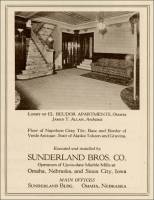
Executed and installed by Sunderland Bros. Co. - Main Offices: Sunderland Bldg., Omaha, Nebraska
Operators of up-to-date Marble Mills at Omaha, Nebraska, and Sioux City, Iowa.
- Omaha, Nebraska – the El Buedor Apartment – the Floor (from Napoleon Gray, An Adaptable Marble, Phenix Marble Company, Kansas City, Missouri, Producers, and Tompkins-Kiel Marble Company, New York City, New York, Distributors, 1926, pp. 32)
- Omaha, Nebraska - the Hayden Block Building (from Missouri Marble, by Norman S. Hinchey, Report of Investigations No. 3, Missouri Geological Survey and Water Resources, Rolla, Missouri, 1946)
Warrensburg sandstone quarried from the Pickel Sandstone Quarry located north of Warrensburg, Missouri, was used in the construction of the Hayden Block building prior to 1904.
-
Omaha, Nebraska – a High School Bath Installation (from Napoleon Gray, An Adaptable Marble, Phenix Marble Company, Kansas City, Missouri, Producers, and Tompkins-Kiel Marble Company, New York City, New York, Distributors, 1926, pp. 29)
- Omaha, Nebraska - the J. H. Green Building (from Missouri Marble, by Norman S. Hinchey, Report of Investigations No. 3, Missouri Geological Survey and Water Resources, Rolla, Missouri, 1946)
Warrensburg sandstone quarried from the Pickel Sandstone Quarry located north of Warrensburg, Missouri, was used in the construction of the J. H. Green building prior to 1904.
- Omaha, Nebraska - the Johnson Residence (from Missouri Marble, by Norman S. Hinchey, Report of Investigations No. 3, Missouri Geological Survey and Water Resources, Rolla, Missouri, 1946)
Warrensburg sandstone quarried from the Pickel Sandstone Quarry located north of Warrensburg, Missouri, was used in the construction of the Johnson residence prior to 1904.
- Omaha, Nebraska - the Martin Building (from Missouri Marble, by Norman S. Hinchey, Report of Investigations No. 3, Missouri Geological Survey and Water Resources, Rolla, Missouri, 1946)
Warrensburg sandstone quarried from the Pickel Sandstone Quarry located north of Warrensburg, Missouri, was used in the construction of the Martin building prior to 1904.
-
Omaha, Nebraska – the Masonic Temple – the Floor, Stairs, & Walls (from Napoleon Gray, An Adaptable Marble, Phenix Marble Company, Kansas City, Missouri, Producers, and Tompkins-Kiel Marble Company, New York City, New York, Distributors, 1926, pp. 34)
- Omaha, Nebraska - the Municipal Building (from Missouri Marble, by Norman S. Hinchey, Report of Investigations No. 3, Missouri Geological Survey and Water Resources, Rolla, Missouri, 1946.)
Ste. Genevieve Golden Vein Marble, quarried in Ste. Genevieve County, Missouri, was used in the construction of the Municipal building.
- Omaha, Nebraska - the Orpheum Theater Stairway (from Throvgh The Ages Magazine, “Stairways In Marble,” July 1923, Vol. 1, No. 3, pp. 10.)
- Omaha, Nebraska -
the Paxton Building (from “Notes
on The Building Stones, Clays and Sands of Iron, St. Francois and
Madison Counties,” by G. E. Ladd, Assistant
Geologist, in Bulletin 1, Geological Survey of Missouri,
Jefferson City, April 1890.)
Granite quarried from one of the quarries at Graniteville, Iron County, Missouri, operated by the Syenite Granite Company, was used in the construction of the Paxton building. “The color of this stone is red or dark pink, mottled with gray and black, the red shades being due to feldspar, the others to a more or less smoky quartz. The rock takes a high, lustrous and handsome polish....”
- Omaha, Nebraska – the PaxtonBuilding (from The Quarrying Industry of Missouri, by Ernest Robertson Buckley and H. A. Buehler, 1904, page 74)
Deep red colored granite quarried in the Graniteville, Missouri, quarries was used with wholly or in part in the construction of the Paxton building.
- Omaha, Nebraska – the PaxtonBuilding (from The Quarrying Industry of Missouri, by Ernest Robertson Buckley and H. A. Buehler, 1904, page 74)
- Omaha, Nebraska -
the Peters National Bank and Peters Trust Co. - the Public Lobby (Sunderland
Bros. Co. advertisement from Throvgh
The Ages Magazine, April 1924, Vol. 1, No. 12, pp. 67. This
advertisement was found in a bound book of many issues of Throvgh
The Ages Magazine at the back of the book.)
Public Lobby, Peters National Bank & Peters Trust Co., Omaha, Nebraska. Napoleon Gray Wainscot and Bank Screen; Tennessee Floor. Fabricated and installed by Sunderland Bros. Co. 
Sunderland Bros. Co. - Main Offices, Sunderland Bldg., Omaha, Nebraska
Operators of Up-to-date Marble Mills at Omaha, Nebraska, and Sioux City, Iowa
-
Omaha, Nebraska – Peters National Bank & Peters Trust Company – the Wainscot & Bank Screen (from Napoleon Gray, An Adaptable Marble, Phenix Marble Company, Kansas City, Missouri, Producers, and Tompkins-Kiel Marble Company, New York City, New York, Distributors, 1926, pp. 9)
- Omaha, Nebraska – the Rialto Theater – the Lobby (from Napoleon Gray, An Adaptable Marble, Phenix Marble Company, Kansas City, Missouri, Producers, and Tompkins-Kiel Marble Company, New York City, New York, Distributors, 1926, pp. 39)
- Omaha, Nebraska - the Rialto Theater - the Lobby (from article entitled, “Marble in Omaha Buildings: The Rapid Increase in the Use of Marble Typifies the General Progressiveness of the City,” in Throvgh The Ages Magazine, October 1926, Vol. 4, No. 6, pp. 5-9.)
- Omaha, Nebraska - the Sunderland Building - Elevator Lobby Floor Border (from Throvgh The Ages Magazine, January 1926, Vol. 3, No. 9, pp. 49. This advertisement was also published in the following issue of Through The Ages Magazine: April 1926, Vol. 3, No. 12, pp. 49.)
- Omaha, Nebraska - the St. Johns Church (from Missouri Marble, by Norman S. Hinchey, Report of Investigations No. 3, Missouri Geological Survey and Water Resources, Rolla, Missouri, 1946)
Warrensburg sandstone quarried from the Pickel Sandstone Quarry located north of Warrensburg, Missouri, was used in the construction of the St. Johns Church building prior to 1904.
- Omaha, Nebraska - the Technical High School (from article entitled, “Marble in Omaha Buildings: The Rapid Increase in the Use of Marble Typifies the General Progressiveness of the City,” in Throvgh The Ages Magazine, October 1926, Vol. 4, No. 6, pp. 5-9.)
“Among the points of interest in Omaha is the Technical High School, a huge building covering acres of ground, and dedicated to instruction in vocational and technical trades....”
“Seven carloads of Napoleon Gray marble, from the quarries of Missouri, were required for the shower room installation. The obvious advantages - the fact that marble is self-supporting, requiring no iron bands; that water will not hurt it; and that it is easily cleaned, and for practical purposes, indestructible - make marble the logical choice for installations of this nature.”
- Omaha, Nebraska - the U.S. Post Office or Court House Buildings (from Missouri Marble, by Norman S. Hinchey, Report of Investigations No. 3, Missouri Geological Survey and Water Resources, Rolla, Missouri, 1946.
Marble quarried from the Phenix Marble Company’s “Old West Quarry” at Phenix, Greene County, Missouri, was used in the construction of the U.S. Post Office or Court House buildings prior to 1942.
- Omaha, Nebraska - the Water Works Building (from Missouri Marble, by Norman S. Hinchey, Report of Investigations No. 3, Missouri Geological Survey and Water Resources, Rolla, Missouri, 1946)
Warrensburg sandstone quarried from the Pickel Sandstone Quarry located north of Warrensburg, Missouri, was used in the construction of the Water Works building prior to 1904.
- Omaha, Nebraska - the Y.M.C.A. Building (from Missouri Marble, by Norman S. Hinchey, Report of Investigations No. 3, Missouri Geological Survey and Water Resources, Rolla, Missouri, 1946)
Warrensburg sandstone quarried from the Pickel Sandstone Quarry located north of Warrensburg, Missouri, was used in the construction of the Y.M.C.A. building prior to 1904.
- Red Bud, Nebraska - the United States Post Office (from Missouri Marble, by Norman S. Hinchey, Report of Investigations No. 3, Missouri Geological Survey and Water Resources, Rolla, Missouri, 1946. Used with permission of the Missouri Department of Natural Resources.)
Eldorado or Ste. Genevieve Istrian Marble quarried from the Inkley Marble Quarries Company quarry located southwest of Ste. Genevieve, Missouri, was used in the construction of the Post Office in Red Bud.
“Napoleon Gray floor in the El Buedor Apartment, at Omaha, Nebraska. James T. Allen, Omaha, Architect; Marble Contractor, Sunderland Bros. Co., Omaha.” (pp. 32) 
“The Masonic Temple at Omaha, Nebraska, has Napoleon Gray marble in the floor, stairs and walls. George B. Prinz, Omaha, Architect; Marble Contractor, Sunderland Bros. Co., Omaha.” (pp. 34) 
“Napoleon Gray wainscot and bank screen, Peters National Bank & Peters Trust Co, Omaha, Neb., John Latenser & Sons, Omaha, Architects; Sunderland Bros. Co., Omaha, Marble Contractors.” (pp. 9) 
“The lobby of the Rialto Theater, Omaha, Nebraska, was executed largely in Napoleon Gray marble. John Latenser & Sons, Omaha, Architect; Marble Contractor, Sunderland Bros. Co., Omaha.” (pp. 39) 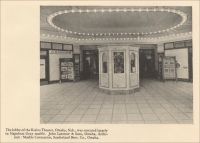
Part of the lobby of the Rialto Theater, Omaha. The walls and stairway are finished in Alaska marble; the floor is Napoleon Gray. 
-
Blair, Nebraska – the Blair Court House Building (from Missouri Marble,
by Norman S. Hinchey, Report of Investigations No. 3, Missouri Geological
Survey and Water Resources, Rolla, Missouri, 1946. Used with permission
of the Missouri Department of Natural Resources.)
Commercial use of material within this site is strictly prohibited. It is not to be captured, reworked, and placed inside another web site ©. All rights reserved. Peggy B. and George (Pat) Perazzo.

